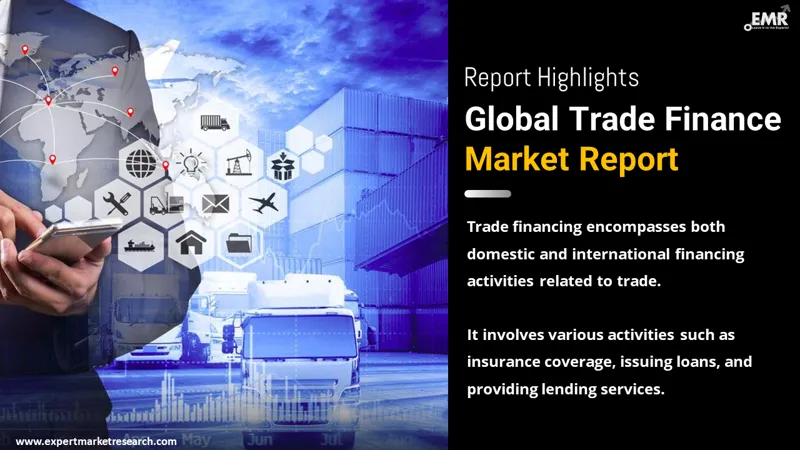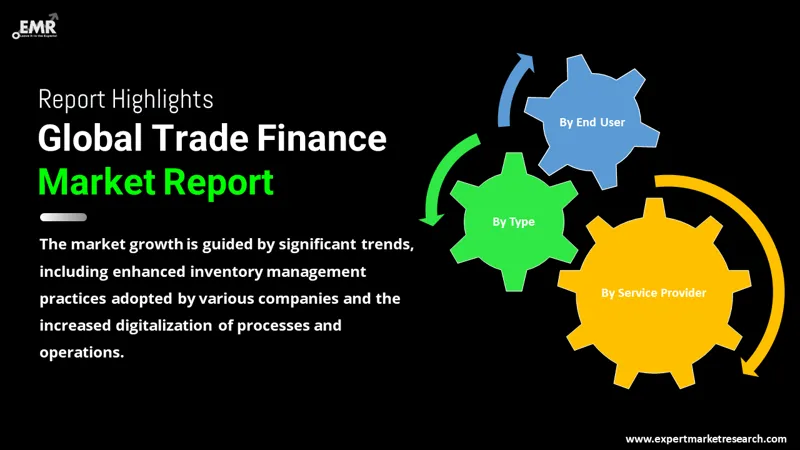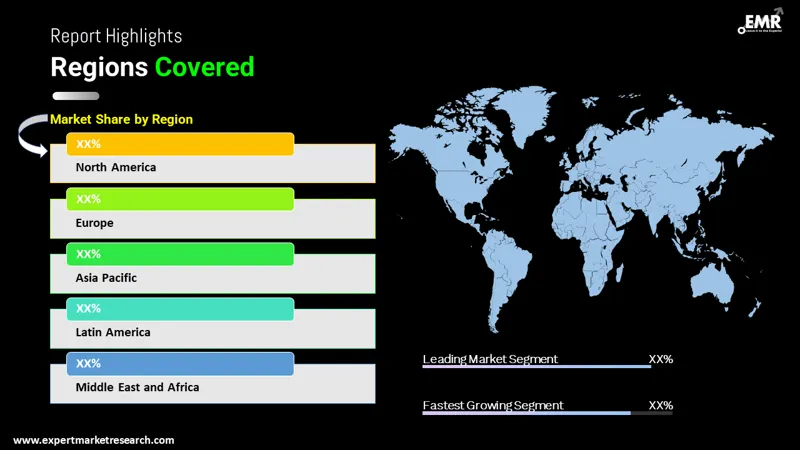Reports
Sale

Global Trade Finance Market Size, Share, Growth, Trends: By Type: Supply Chain Finance, Structured Trade Finance, Traditional Trade Finance; By Service Providers: Banks, Trade Finance Houses, Others; By End User: Exporters, Importers, Traders, Others; Regional Analysis; Market Dynamics: SWOT Analysis; Competitive Landscape; 2024-2032
Global Trade Finance Market Outlook
The global trade finance market size reached approximately USD 45.79 billion in 2023. The market is projected to grow at a CAGR of 4.3% between 2024 and 2032, reaching a value of around USD 66.74 billion by 2032.
Key Takeaways
- A primary function of trade finance is to manage risks associated with international trade, including credit risk.
- Supply chain finance is a growing segment within trade finance, focusing on optimising working capital and strengthening supply chains.
- The trade finance market is undergoing significant digitalisation, with technologies like blockchain, AI, and the Internet of Things (IoT).
Trade financing represents a range of financial instruments and products used by companies to facilitate international trade and commerce and deals with domestic and international trade financing activities such as insurance, loan issuance, and lending, among others. It is essentially the fuel that drives global trade by mitigating the risks associated with transactions that involve multiple parties, often in different countries with different laws, customs, and levels of economic stability.
The trade finance market growth is being driven by the need to improve inventory management as well as increased digitalisation and the development of tools for risk management. The availability of easy procedures for short-term financing is another major advantage provided by the trade finance sector. Technological advances and enhanced strategic formulation, along with the adoption of structuring and pricing tools, also offer various opportunities for market growth. Rapid economic growth in emerging markets leads to an increase in import and export activities as businesses in these markets are increasingly seeking trade finance services to facilitate their international trade endeavours.

Read more about this report - REQUEST FREE SAMPLE COPY IN PDF
Key Trends and Developments
Growth of sustainable and ethical trade financing; increased focus on SMEs; supply chain finance (SCF) growth; and cross-border collaboration and partnerships are the major trends in the trade finance market
| Date | Event |
| Jan 2024 | Yes Bank marked a milestone by becoming the inaugural Indian bank to carry out an export finance operation through the International Trade Financing Services Platform (ITFS) operated by RXIL Global IFSC Limited (RXIL). |
| Jan 2024 | The Asian Development Bank (ADB) and British International Investment (BII) initiated a new collaboration aimed at promoting green trade finance in the Asia Pacific region. |
| Jan 2024 | Deutsche Bank, based in Frankfurt, released the fifth edition of its Trafin securitization program. This program offers credit protection for a trade finance asset portfolio valued at US$3.5 billion. |
| Oct 2023 | Supply chain FinTech firm Twinco Capital successfully obtained an additional facility of USD 53 million from BBVA Spark to assist small to medium-sized enterprises in emerging nations get access to trade finance. |
| Trends | Impact |
| Growth of sustainable and ethical trade financing | Sustainable trade finance is gaining prominence, with a focus on supporting transactions that adhere to environmental, social, and governance (ESG) criteria. |
| Increased focus on SMEs in trade finance | There is a growing focus on developing products and solutions tailored to the needs of SMEs to bridge the trade finance gap. |
| Growth of the supply chain finance (SCF) segment within the market | SCF solutions help businesses manage payment terms and improve cash flow, contributing to the resilience of supply chains. |
| Cross-border collaboration and partnerships | These collaborations aim to standardise processes, reduce trade barriers, and facilitate more efficient cross-border transactions. |
Trade Finance Market Trends
Sustainable trade finance is an emerging trend that aligns financial services with sustainable development goals, focusing on supporting trade transactions that meet specific Environmental, Social, and Governance (ESG) criteria. This approach integrates sustainability considerations into financial operations, aiming to promote responsible business practices and contribute to a more sustainable global economy.
Trade finance instruments are increasingly used to support transactions involving goods and services that have a positive environmental impact. This includes the trade of renewable energy equipment, sustainable agriculture products, and other goods that contribute to environmental conservation and the reduction of carbon emissions, promoting the trade finance market expansion.
In October 2023, supply chain FinTech firm Twinco Capital, secured a significant financial boost by obtaining an additional facility of USD 53 million from BBVA Spark. This funding was a strategic move to support small to medium-sized enterprises (SMEs) in emerging countries by providing them with much-needed access to trade finance. The financial support from BBVA Spark was aimed at addressing a crucial gap in the market which is the lack of accessible financing options for SMEs in developing regions.

Read more about this report - REQUEST FREE SAMPLE COPY IN PDF
Market Segmentation
“Trade Finance Market Report and Forecast 2024-2032” offers a detailed analysis of the market based on the following segments:
| Market Breakup | Categories |
| Type | Supply Chain Finance, Structured Trade Finance, Traditional Trade Finance |
| Service Provider | Banks, Trade Finance Houses, Others |
| End User | Exporters, Importers, Traders, Others |
| Region | North America, Europe, Asia Pacific, Latin America, Middle East and Africa |
Banks occupy a dominant trade finance market share as they are instrumental in offering the services required for international trade
Banks offer various products and services to mitigate risks involved in international trade, such as credit risk, currency risk, and country risk which include export credit insurance, foreign exchange hedging, and political risk insurance.
Banks account for a major share of the market due to their pivotal role in providing the financial services and instruments necessary for facilitating international trade. Banks issue LCs, which are one of the most common and trusted instruments in trade finance. An LC provides a guarantee from a bank that payment will be made to the exporter, provided that the terms and conditions stated in the LC are met which reduces the payment risk for exporters and the non-delivery risk for importers.
Meanwhile, trade finance houses, also known as specialist trade finance institutions, hold a substantial share of the trade finance market alongside traditional banks. These institutions specialise in providing trade financing solutions and services, and they play a crucial role in facilitating international trade, particularly for small and medium-sized enterprises (SMEs) and in markets where access to traditional banking services may be limited or more restrictive.
Trade finance houses specialise in trade finance and often possess deep expertise in this field and understand the complexities of international trade, including the various risks and regulatory requirements, and can provide tailored solutions to meet the specific needs of businesses.
Exporters and importers account for the majority of the trade finance market share as they form a crucial part of the international trade
Companies involved in export services face the risk of non-payment or delayed payment from foreign buyers. Trade finance instruments like letters of credit (LCs) provide assurance to exporters that they will receive payment, as the issuing bank guarantees payment upon fulfilment of the terms in the LC. Trade finance solutions help exporters manage their cash flow as export transactions can have long lead times, and exporters often need to invest in producing or procuring goods long before they receive payment.
The importers, who are key participants in international trade, also influence the overall demand. Importers, or businesses that purchase goods or services from foreign countries, face unique risks and challenges when engaging in cross-border transactions. Trade finance provides importers with a variety of financial tools and services to facilitate and secure their international purchases and contribute to the trade finance market development. Importers are concerned about the risks associated with the non-delivery or delayed delivery of goods and trade finance instruments like letters of credit (LCs) offer assurance to importers by ensuring that payment is only made upon the confirmation that the goods have been shipped as per the contractual agreement.

Read more about this report - REQUEST FREE SAMPLE COPY IN PDF
Competitive Landscape
The market players are increasing their collaboration efforts and are focusing on mergers and acquisitions to gain a competitive edge in the market
| Company | Headquarters | Primary Services |
| Citigroup Inc. | New York, United States | Citi Retail Banking, CitiMortgage, Citi Branded Cards |
| Asian Development Bank | Metro Manila, Philippines | Poverty reduction, infrastructure development, environmental improvement |
| DBS Bank Ltd | Marina Bay, Singapore | Consumer banking, wealth management, SME banking |
| JPMorgan Chase & Co. | New York, United States | Consumer & community banking, corporate & investment banking, asset & wealth management |
Other players include BNP Paribas, HSBC Holdings PLC, Euler Hermes, and Standard Chartered Bank, among others.
The players in the trade finance market are increasingly collaborating to promote green trade finance as part of a broader shift towards sustainable business practices and environmental stewardship. Companies are recognising the importance of addressing environmental challenges such as climate change, resource depletion, and pollution and by collaborating, they can pool their resources, expertise, and influence to support environmentally sustainable trade practices.
Trade Finance Market Analysis by Region
The demand for trade finance in North America is shaped by a variety of factors. North America, primarily driven by the economies of the United States and Canada, features robust economic activity, including significant import and export operations. The need to finance and secure these trade activities fuels the demand for various trade finance solutions. With extensive global trade relationships, businesses in North America require trade finance services to mitigate the risks associated with international trade, including currency fluctuations, non-payment, and supply chain disruptions.
The Asia Pacific trade finance market is expected to continue to grow, driven by the region's robust economic development, expanding trade activities, and increasing technological improvements. Many countries in the Asia Pacific region are experiencing rapid economic growth, leading to an increase in trade activities both within the region and with the rest of the world and this growth fuels the demand for trade finance to support and secure these transactions.
Key Highlights of the Report
| REPORT FEATURES | DETAILS |
| Base Year | 2023 |
| Historical Period | 2018-2023 |
| Forecast Period | 2024-2032 |
| Scope of the Report |
Historical and Forecast Trends, Industry Drivers and Constraints, Historical and Forecast Market Analysis by Segment:
|
| Breakup by Type |
|
| Breakup by Service Provider |
|
| Breakup by End User |
|
| Breakup by Region |
|
| Market Dynamics |
|
| Competitive Landscape |
|
| Companies Covered |
|
| Report Price and Purchase Option | Explore our purchase options that are best suited to your resources and industry needs. |
| Delivery Format | Delivered as an attached PDF and Excel through email, with an option of receiving an editable PPT, according to the purchase option. |
*At Expert Market Research, we strive to always give you current and accurate information. The numbers depicted in the description are indicative and may differ from the actual numbers in the final EMR report.
1 Preface
2 Report Coverage – Key Segmentation and Scope
3 Report Description
3.1 Market Definition and Outlook
3.2 Properties and Applications
3.3 Market Analysis
3.4 Key Players
4 Key Assumptions
5 Executive Summary
5.1 Overview
5.2 Key Drivers
5.3 Key Developments
5.4 Competitive Structure
5.5 Key Industrial Trends
6 Snapshot
6.1 Global
6.2 Regional
7 Opportunities and Challenges in the Market
8 Global Trade Finance Market Analysis
8.1 Key Industry Highlights
8.2 Global Trade Finance Historical Market (2018-2023)
8.3 Global Trade Finance Market Forecast (2024-2032)
8.4 Global Trade Finance Market by Type
8.4.1 Supply Chain Finance
8.4.1.1 Historical Trend (2018-2023)
8.4.1.2 Forecast Trend (2024-2032)
8.4.2 Structured Trade Finance
8.4.2.1 Historical Trend (2018-2023)
8.4.2.2 Forecast Trend (2024-2032)
8.4.3 Traditional Trade Finance
8.4.3.1 Historical Trend (2018-2023)
8.4.3.2 Forecast Trend (2024-2032)
8.5 Global Trade Finance Market by Service Provider
8.5.1 Banks
8.5.1.1 Historical Trend (2018-2023)
8.5.1.2 Forecast Trend (2024-2032)
8.5.2 Trade Finance Houses
8.5.2.1 Historical Trend (2018-2023)
8.5.2.2 Forecast Trend (2024-2032)
8.5.3 Others
8.6 Global Trade Finance Market by End User
8.6.1 Exporters
8.6.1.1 Historical Trend (2018-2023)
8.6.1.2 Forecast Trend (2024-2032)
8.6.2 Importers
8.6.2.1 Historical Trend (2018-2023)
8.6.2.2 Forecast Trend (2024-2032)
8.6.3 Traders
8.6.3.1 Historical Trend (2018-2023)
8.6.3.2 Forecast Trend (2024-2032)
8.6.4 Others
8.7 Global Trade Finance Market by Region
8.7.1 North America
8.7.1.1 Historical Trend (2018-2023)
8.7.1.2 Forecast Trend (2024-2032)
8.7.2 Europe
8.7.2.1 Historical Trend (2018-2023)
8.7.2.2 Forecast Trend (2024-2032)
8.7.3 Asia Pacific
8.7.3.1 Historical Trend (2018-2023)
8.7.3.2 Forecast Trend (2024-2032)
8.7.4 Latin America
8.7.4.1 Historical Trend (2018-2023)
8.7.4.2 Forecast Trend (2024-2032)
8.7.5 Middle East and Africa
8.7.5.1 Historical Trend (2018-2023)
8.7.5.2 Forecast Trend (2024-2032)
9 North America Trade Finance Market Analysis
9.1 United States of America
9.1.1 Historical Trend (2018-2023)
9.1.2 Forecast Trend (2024-2032)
9.2 Canada
9.2.1 Historical Trend (2018-2023)
9.2.2 Forecast Trend (2024-2032)
10 Europe Trade Finance Market Analysis
10.1 United Kingdom
10.1.1 Historical Trend (2018-2023)
10.1.2 Forecast Trend (2024-2032)
10.2 Germany
10.2.1 Historical Trend (2018-2023)
10.2.2 Forecast Trend (2024-2032)
10.3 France
10.3.1 Historical Trend (2018-2023)
10.3.2 Forecast Trend (2024-2032)
10.4 Italy
10.4.1 Historical Trend (2018-2023)
10.4.2 Forecast Trend (2024-2032)
10.5 Others
11 Asia Pacific Trade Finance Market Analysis
11.1 China
11.1.1 Historical Trend (2018-2023)
11.1.2 Forecast Trend (2024-2032)
11.2 Japan
11.2.1 Historical Trend (2018-2023)
11.2.2 Forecast Trend (2024-2032)
11.3 India
11.3.1 Historical Trend (2018-2023)
11.3.2 Forecast Trend (2024-2032)
11.4 ASEAN
11.4.1 Historical Trend (2018-2023)
11.4.2 Forecast Trend (2024-2032)
11.5 Australia
11.5.1 Historical Trend (2018-2023)
11.5.2 Forecast Trend (2024-2032)
11.6 Others
12 Latin America Trade Finance Market Analysis
12.1 Brazil
12.1.1 Historical Trend (2018-2023)
12.1.2 Forecast Trend (2024-2032)
12.2 Argentina
12.2.1 Historical Trend (2018-2023)
12.2.2 Forecast Trend (2024-2032)
12.3 Mexico
12.3.1 Historical Trend (2018-2023)
12.3.2 Forecast Trend (2024-2032)
12.4 Others
13 Middle East and Africa Trade Finance Market Analysis
13.1 Saudi Arabia
13.1.1 Historical Trend (2018-2023)
13.1.2 Forecast Trend (2024-2032)
13.2 United Arab Emirates
13.2.1 Historical Trend (2018-2023)
13.2.2 Forecast Trend (2024-2032)
13.3 Nigeria
13.3.1 Historical Trend (2018-2023)
13.3.2 Forecast Trend (2024-2032)
13.4 South Africa
13.4.1 Historical Trend (2018-2023)
13.4.2 Forecast Trend (2024-2032)
13.5 Others
14 Market Dynamics
14.1 SWOT Analysis
14.1.1 Strengths
14.1.2 Weaknesses
14.1.3 Opportunities
14.1.4 Threats
14.2 Porter’s Five Forces Analysis
14.2.1 Supplier’s Power
14.2.2 Buyer’s Power
14.2.3 Threat of New Entrants
14.2.4 Degree of Rivalry
14.2.5 Threat of Substitutes
14.3 Key Indicators for Demand
14.4 Key Indicators for Price
15 Competitive Landscape
15.1 Market Structure
15.2 Company Profiles
15.2.1 Citigroup Inc.
15.2.1.1 Company Overview
15.2.1.2 Financial Analysis
15.2.2 Asian Development Bank
15.2.2.1 Company Overview
15.2.2.2 Financial Analysis
15.2.3 DBS Bank Ltd
15.2.3.1 Company Overview
15.2.3.2 Financial Analysis
15.2.4 JPMorgan Chase & Co.
15.2.4.1 Company Overview
15.2.4.2 Financial Analysis
15.2.5 BNP Paribas
15.2.5.1 Company Overview
15.2.5.2 Financial Analysis
15.2.6 HSBC Holdings PLC
15.2.6.1 Company Overview
15.2.6.2 Financial Analysis
15.2.7 Euler Hermes
15.2.7.1 Company Overview
15.2.7.2 Financial Analysis
15.2.8 Standard Chartered Bank
15.2.8.1 Company Overview
15.2.8.2 Financial Analysis
15.2.9 Others
16 Key Trends and Developments in the Market
List of Key Figures and Tables
1. Global Trade Finance Market: Key Industry Highlights, 2018 and 2032
2. Global Trade Finance Historical Market: Breakup by Type (USD Billion), 2018-2023
3. Global Trade Finance Market Forecast: Breakup by Type (USD Billion), 2024-2032
4. Global Trade Finance Historical Market: Breakup by Service Provider (USD Billion), 2018-2023
5. Global Trade Finance Market Forecast: Breakup by Service Provider (USD Billion), 2024-2032
6. Global Trade Finance Historical Market: Breakup by End User (USD Billion), 2018-2023
7. Global Trade Finance Market Forecast: Breakup by End User (USD Billion), 2024-2032
8. Global Trade Finance Historical Market: Breakup by Region (USD Billion), 2018-2023
9. Global Trade Finance Market Forecast: Breakup by Region (USD Billion), 2024-2032
10. North America Trade Finance Historical Market: Breakup by Country (USD Billion), 2018-2023
11. North America Trade Finance Market Forecast: Breakup by Country (USD Billion), 2024-2032
12. Europe Trade Finance Historical Market: Breakup by Country (USD Billion), 2018-2023
13. Europe Trade Finance Market Forecast: Breakup by Country (USD Billion), 2024-2032
14. Asia Pacific Trade Finance Historical Market: Breakup by Country (USD Billion), 2018-2023
15. Asia Pacific Trade Finance Market Forecast: Breakup by Country (USD Billion), 2024-2032
16. Latin America Trade Finance Historical Market: Breakup by Country (USD Billion), 2018-2023
17. Latin America Trade Finance Market Forecast: Breakup by Country (USD Billion), 2024-2032
18. Middle East and Africa Trade Finance Historical Market: Breakup by Country (USD Billion), 2018-2023
19. Middle East and Africa Trade Finance Market Forecast: Breakup by Country (USD Billion), 2024-2032
20. Global Trade Finance Market Structure
The global trade finance market reached a value of USD 45.79 billion in 2023.
The market is projected to grow at a CAGR of 4.3% between 2024 and 2032.
The market is estimated to witness a healthy growth during 2024-2032 to reach around USD 66.74 billion by 2032.
The key trends guiding the growth of the market include the improved inventory management by different companies and increased digitalisation.
The major regions in the market are North America, Latin America, the Middle East and Africa, Europe, and the Asia Pacific.
Supply chain finance, structured trade finance, and traditional trade finance are the major types in the market.
The several end users of trade finance are exporters, importers, and traders, among others.
The significant service providers in the market include banks and trade finance houses, among others.
The major drivers of the market include rapid urbanisation and globalisation, the development of risk management applications for financial sectors, technological advancements and enhanced strategic formulation, the adoption of structuring and pricing tools, and the availability of easy procedures for short-term financing.
The major players in the market are Citigroup Inc., Asian Development Bank, DBS Bank Ltd, JPMorgan Chase & Co., BNP Paribas, HSBC Holdings PLC, Euler Hermes, and Standard Chartered Bank, among others.
The global trade finance market attained a value of USD 45.79 billion in 2023, driven by the improved inventory management policies. Aided by the technological advancements and enhanced strategic formulation, the market is expected to witness a further growth in the forecast period of 2024-2032, growing at a CAGR of 4.3%.
EMR’s meticulous research methodology delves deep into the market, covering the macro and micro aspects of the industry. Based on types, the industry can be bifurcated into supply chain finance, structured trade finance, and traditional trade finance. On the basis of end-use segments, the industry is divided into exporters, importers, and traders, among others. On the basis of service provider, the industry is segmented into banks, and trade finance houses, among others. The major regional markets for trade finance are North America, Europe, the Asia Pacific, Latin America, and the Middle East and Africa. The key players in the above market includeCitigroup Inc., Asian Development Bank, DBS Bank Ltd, JPMorgan Chase & Co., BNP Paribas, HSBC Holdings PLC, Euler Hermes, Standard Chartered Bank, among others.
EMR’s research methodology uses a combination of cutting-edge analytical tools and the expertise of their highly accomplished team, thus, providing their customers with market insights that are accurate, actionable, and help them remain ahead of their competition.
Mini Report
-
Selected Sections, One User
-
Printing Not Allowed
-
Email Delivery in PDF
-
Free Limited Customisation -
Post Sales Analyst Support -
50% Discount on Next Update
Single User License
-
All Sections, One User
-
One Print Allowed
-
Email Delivery in PDF
-
Free Limited Customisation -
Post Sales Analyst Support -
50% Discount on Next Update

Five User License
-
All Sections, Five Users
-
Five Prints Allowed
-
Email Delivery in PDF
-
Free Limited Customisation
-
Post Sales Analyst Support
-
50% Discount on Next Update
Corporate License
-
All Sections, Unlimited Users
-
Unlimited Prints Allowed
-
Email Delivery in PDF + Excel
-
Free Limited Customisation
-
Post Sales Analyst Support
-
50% Discount on Next Update
Any Question? Speak With An Analyst
View A Sample
Did You Miss Anything, Ask Now
Right People
We are technically excellent, strategic, practical, experienced and efficient; our analysts are hand-picked based on having the right attributes to work successfully and execute projects based on your expectations.
Right Methodology
We leverage our cutting-edge technology, our access to trusted databases, and our knowledge of the current models used in the market to deliver you research solutions that are tailored to your needs and put you ahead of the curve.
Right Price
We deliver in-depth and superior quality research in prices that are reasonable, unmatchable, and shows our understanding of your resource structure. We, additionally, offer attractive discounts on our upcoming reports.
Right Support
Our team of expert analysts are at your beck and call to deliver you optimum results that are customised to meet your precise needs within the specified timeframe and help you form a better understanding of the industry.


